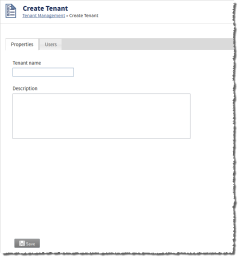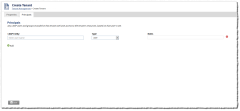Fields: Create/ Edit Tenant
Path: Administration > Tenant Management > New
Path: Administration > Tenant Management > Edit
The
Properties
Use this section of the form to specify general information for your tenant.

|
|
Click to enlarge |
Tenant name
Lets you specify the name of the tenant.
Description
(Optional) Lets you specify a text description of the tenant.
Nodes
(Edit Tenant only) Displays the number of nodes assigned to the tenant. To add or remove nodes on a tenant, see Assigning tenants to nodes.
Services
(Edit Tenant only) Displays the number of services owned by this tenant.
Service Templates
(Edit Tenant only) Displays the number of service templates owned by this tenant.
Principals
In this section of the form, you can add LDAP entities (users, organizational unit, group) to this tenant. You can also specify the roles given to this tenant.

|
|
Click to enlarge |
LDAP Entity
Lets you specify the name of the LDAP entity. For a User type, this is simply the name (for example, "hpotter"). If the type is Group or OU, you must provide the entire distinguished name.
Open and close parentheses—"(" and ")"—are not supported characters in common name ("CN") LDAP entries. Other special characters, such as back-slashes, commas, etc., must be escaped properly. This includes a second backslash ("\\,") when specifying the OU or Group name (because the JVM interpolates one of the backslashes before passing the information on to MWS).
Type
Lets you specify the type of LDAP entity you are adding. This can be a user, OU (organizational unit), or group.
Roles
Lets you specify the role(s) of the tenant. This is an auto complete field that will suggest roles from those you have already created as you type.
To add additional LDAP entities to this tenant, choose Add ( ). To remove LDAP entities, choose Remove (
). To remove LDAP entities, choose Remove ( ).
).
Save
Lets you save the tenant.
Related topics